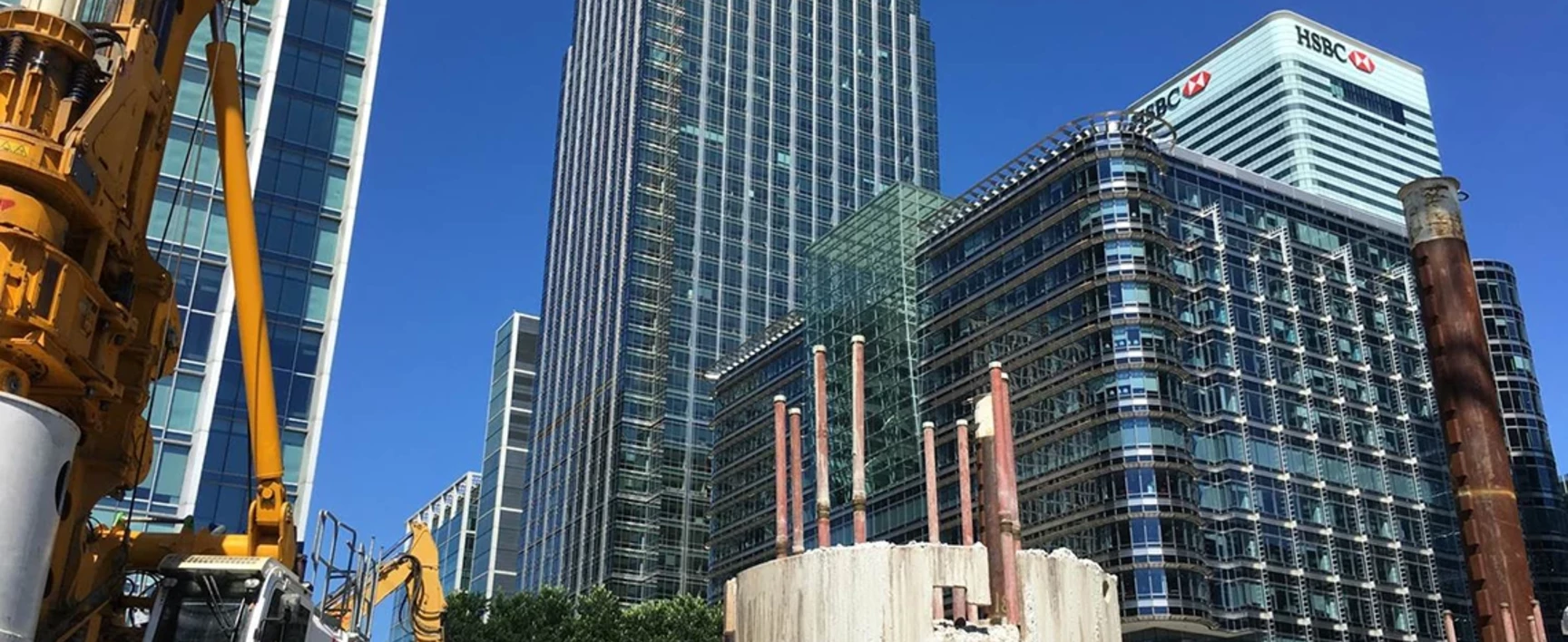With our extensive expertise in deep foundation testing, we were engaged to assess the piles by load and integrity testing during the course of the project, in addition to providing compressive strength testing of the concrete used in the foundation piles.

Case Study
Breathing New Life into London’s Docklands

Wood Wharf on the Isle of Dogs in East London has been earmarked for an ambitious project to regenerate more than 22 acres of former dockland adjacent to the Canary Wharf financial district. Due to be completed in 2023, the scheme will see the construction of a number of skyscrapers, with the aim of creating some 3,200 new homes, nearly two million square feet of office space, and a further 340,000 square feet of shops and restaurants along the Thames waterfront.
Ground engineering contractor, Expanded Geotechnical, part of the Laing O’Rourke Group, was contracted to lay the foundations for the first three buildings in the development. As parts of these buildings were to be built over water, this involved boring steel cased marine piles directly into the bed of the Wood Wharf basin. Deep bored base grouted piles were also installed on land reclaimed from the former dock. These methods were vital to allow the construction of the 60 storey A1 tower at the heart of the Wood Wharf project, installing foundations capable of supporting their immense weight and lateral loads.
Wood Wharf on the Isle of Dogs in East London has been earmarked for an ambitious project to regenerate more than 22 acres of former dockland adjacent to the Canary Wharf financial district. Due to be completed in 2023, the scheme will see the construction of a number of skyscrapers, with the aim of creating some 3,200 new homes, nearly two million square feet of office space, and a further 340,000 square feet of shops and restaurants along the Thames waterfront.
Ground engineering contractor, Expanded Geotechnical, part of the Laing O’Rourke Group, was contracted to lay the foundations for the first three buildings in the development. As parts of these buildings were to be built over water, this involved boring steel cased marine piles directly into the bed of the Wood Wharf basin. Deep bored base grouted piles were also installed on land reclaimed from the former dock. These methods were vital to allow the construction of the 60 storey A1 tower at the heart of the Wood Wharf project, installing foundations capable of supporting their immense weight and lateral loads.
With its extensive expertise in deep foundation testing, we were engaged to assess the piles by load and integrity testing during the course of the project. In addition, we provided compressive strength testing of the concrete used in the foundation piles. All of this had to be carried out in an extremely time-sensitive manner and alongside other construction projects in the area to ensure there was no delay to the rest of the project.
Testing the Foundations
By providing experienced, dedicated experts, we could be confident it could offer the support required at short notice to achieve Expanded Geotechnical’s goals and give the highest possible standard of service within the strict project timeframes.
On land, our team of consultants tested the large diameter base grouted piles that formed part of the building foundations - created by auger boring deep shafts, into which steel reinforcement cages are installed prior to being filled with concrete. Base grouting is employed to enhance the axial load-bearing performance of auger bored pile foundations. We provided off-site UKAS accredited (no. 0001) concrete testing services to ensure the concrete used met the standards required. These checks included both slump and concrete cube testing, which assess the quality of the concrete over time.
In addition, we offered a range of on-site services to monitor the base grouting process. Taking measurements during the grouting from the deepest point of the pile, known as the toe, is crucial to provide quality assurance and ensure that the pile is able to withstand increased axial loads. We embedded strain transducers in the pile toe, and uplift monitors on the pile head, to provide real-time measurements during the grouting process. With this data, we were able to rapidly confirm base uplift for each pile so the grouting process could be halted at precisely the right time.
Introducing Innovation
A testing method introduced to the UK, Thermal Integrity Profiling (TIP), was also employed on site. Uniformly spaced thermal sensors attached to the reinforcement cage of the pile during the installation process recorded the heat generated by the concrete curing process. This innovative method can give piling contractors knowledge of the quality of the entire cross-section of a concrete pile at an early stage, as the material cures. The data captured can then reveal if the pile is suffering from any potential structural integrity issues which may need to be remedied, such as inclusions or necking.
Sonic Logging was another integrity testing method used on the site. In contrast to TIP, this technique is employed seven or more days after concrete curing. The method involves the lowering of two probes - one a transmitter and the other a receiver - to the bottom of a pile through access tubes cast in the concrete. Sound waves from the transmitter are captured by the receiver as they are simultaneously raised at intervals to the top of the pile. Any variance in the soundwaves captured by the receiver can indicate quality issues or flaws in the structural soundness of the concrete at a given depth.
All data collected from these tests was digitally logged and analysed by our management team. The graphical output of the results were then rapidly fed back to Expanded Geotechnical, advising on the most appropriate testing methods for the other piles on the project to ensure they all offered the required structural integrity.
Bearing the Weight
Thanks to our expertise in pile testing, the performance of building’s foundations was verified. Expanded Geotechnical were then able to demonstrate the foundations for the new development were capable of bearing the weight of the completed building in accordance with the design.
Speaking about the results of the project, Andy Jones, project manager at Expanded Geotechnical, explained: “Every site has its own unique features, which can affect the way piles act under load. This makes it vital for us to test the piles and to verify that the method is giving us a truly accurate picture of the foundation’s performance.
“The commitment and flexibility of the team meant we were able to get the analysis we needed to be confident that the piles being laid met the requirements of the project. In particular, the fast availability of rich data meant that the testing process caused no hold ups to the project itself.”
Martyn Ellis, operations director, Infrastructure Services, concluded: “Contractors need to be sure the piling methods they are using on site are suitable for the intended load. Providing accurate data can help them fully understand exactly how the foundations will behave once the buildings they are intended to support have been built.
“Having a large team available working in partnership with the contractor meant it was possible to minimise turnaround times on data-gathering and reporting. This made sure Expanded Geotechnical had the information it needed to go forward with testing as efficiently as possible, keeping the project on schedule.”





